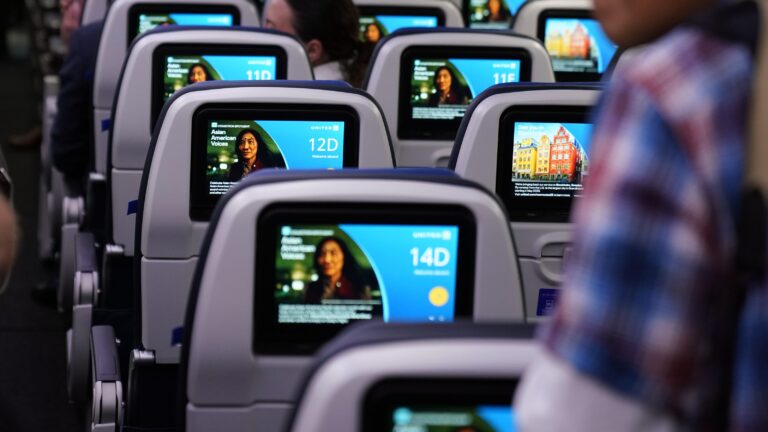- The in-flight entertainment roster provided by airlines is generally safe to watch while on board.
- If you’re watching something on your own device, that’s probably fine too.
- If someone close to you is very uncomfortable with what you are seeing, or you are very uncomfortable with what they are seeing, it’s okay to start a dialogue about it.
Get more stories like this by emailSign up for our travel newsletter here.
Have you ever been on an airplane watching a movie or TV show and suddenly found yourself with a character on screen having sex? This happened to me a few months ago while I was watching “Sex and the City” and it shouldn’t have been that surprising. The act is literally in the show’s title. But I figured airlines would censor anything that was even remotely problematic. So, like they always do, I had a momentary existential crisis. Was I doing something wrong? Should I have been ashamed of my life and my choices?
I’ve always assumed that if an airline has something on their in-flight entertainment system, it’s okay to watch it, but the reality may be a bit more nuanced.
Who gets to decide what to watch on an airplane?
Anything on the airline’s in-flight entertainment roster is free to watch, and as long as you use common sense, most content that passengers download to watch on their own devices is probably fine.
“In the world of etiquette, we have a duty to be considerate of those around us, and that includes what we look at,” Nick Layton, co-host of the podcast “Were You Raised by Wolves?”, told me. “There’s a trade-off there: I’m not going out of my way to make you uncomfortable, and you shouldn’t go out of your way to look at my screen.”
Even professional, travel-loving parents agree that on a plane, each person can more or less choose their own adventure.
“Everyone has a right to see what they want to see; they’re paying for it just like everyone else. If I’m watching a movie with very explicit content and they don’t stop it, I might warn them, but I wouldn’t say, ‘Stop the movie,'” Tavia Carlson, who runs the blog Big Brave Nomad, told me. She said her children, ages 9 and 7, and toddlers are usually distracted by their devices and toys while traveling.

Should your in-flight entertainment choices be dictated by the passenger sitting next to you?
No, but if someone close to you is extremely uncomfortable with what you are seeing, or you are extremely uncomfortable with what they are seeing, it’s okay to start a dialogue about it.
“If you’re a passenger who is uncomfortable watching the movie, you could politely ask, ‘That movie makes me a bit uncomfortable. Can we watch something else?'” Layton says.
Emily Kraus, a content creator who goes by the handle “A Mom Explores,” said that while it may not be ideal for tourists to be viewing sexual or violent material near their children, she didn’t think it was worth making a fuss about.
“I might just cringe a little and hope my kids aren’t looking in that direction,” she told me, “and basically not tell someone to stop watching their favorite show just because they’re on public transportation.”
Do airlines censor in-flight movies?
Another reason why airline-approved in-flight entertainment listings are OK to watch on board is that airlines have the power to change the content on screen if there is truly objectionable content. The amount and type of content that is removed depends on a number of factors, including the cultural sensitivities of the airline’s location, the airline’s own time requirements, and sometimes even director and producer approval.
“If you’re paying for a ticket, everyone has a right to see what they want to see, and we would like to see airlines take the lead on that,” Carlson said.
Still, Layton added that in most cases, people should be able to watch any content they download to their devices freely.
“I don’t want to live in a world where the only movies you can watch on an airplane are G-rated,” he said, but added, “Don’t go out of your way to watch something provocative. You shouldn’t watch porn on an airplane.”
How to be a considerate passenger
As with most etiquette rules, being thoughtful about what you look at on an airplane is another way to show respect for other passengers.
“If I was sitting next to a 6-year-old, I’d definitely be thinking, ‘Should I watch a really adult movie?’ I’d probably think twice,” Leighton says. “You can’t tell what someone’s sensibilities are just by looking at them. You can’t generalize.”
Otherwise, experts agree that you should be on your own, and airlines actually make it easy for you to do that.
“Given that in-flight entertainment requires headphones to be plugged in, that’s half the battle,” Carlson says. “If kids can’t hear it, they’re not going to be very interested.”
But even if the person sitting next to you is easily distracted, the rule of “do what you want, within reason” still applies.
“My children are my personal responsibility, and I usually try to arrange the seating so that they’re not sitting in another adult’s seat. I think it’s more comfortable for the kids,” Kraus said. “If we end up sitting and another adult has to be there, I’m a big supporter of everyone minding their own business.”
Zach Wichter is a New York-based travel writer for USA TODAY. He can be reached at zwichter@usatoday.com.


